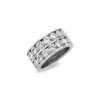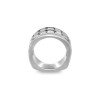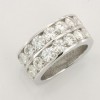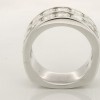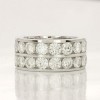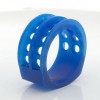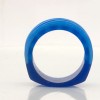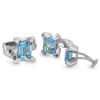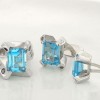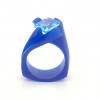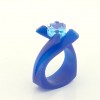Happy Stories From our customers
Read testimonials-
-
Steven’s Bling Ring
Dear Joe,
Once upon a time I met this woman who was to one day become my wife…. Having no idea what to do for wedding bands, I came to you and together we designed my wife’s 3 piece solitaire engagement ring and 2 part wedding bands, and a custom wedding band for myself. Back then it was all we could afford and the rings were testaments to our love for one another.
But then one day many years later, my wife decided that she wanted to have her 3 rings somehow mechanically glued together so they wouldn’t all turn in different directions. And I think this is where it all began……I am now forced to come and meet with you to discuss the metal gluing process…. and somehow we went from gluing (bad Idea), to designing to bigger dialmonds and making a whole new ring (better Idea). I’m not sure how this happened but it turned out to be the most fantastic rings anyone had ever seen. (it would win this contest hands down if it were in the contest)
(contd below pics)
So for the next four years, I had to stare at this really cool over the top bling ring, and listen to all the compliments, and then look down at my old ring in saddend disappointment that mine just wasn’t big enough or pretty enough. (yes size matters) To make matters worse my wife chipped her stone….. and again ……You convinced me to replace it with a bigger center stone. What was I thinking? Now her ring was WAY over the top and my ring was now this inferior little piece of jewlery that just wasn’t good enough any more.
SO ….Thank you for helping me make my dreams come true! Its not fair that my wife got to have you design a really cool ring with all kinds a big crazy diamonds and I had to be stuck with the first ring I could afford to have you design when we got married 8 years ago. Finally….. I now have my own size 14 Bling Ring with 18 1/2 carat diamonds totaling 9 carats. (note 1 more carat that my wife’s ! ) Some people say its crazy, but when they see that its designed in the same style as my wifes they see that it was meant to be!
No one has ever created 2 more perfect rings that go together, and we are showered with complements continuously on how beaiful they are. Mostly from strangers who are complaining about being blinded from yards away, Laugh.
and if you read this story and your thinking why did I go 1 more carat than my wife? Well its pre planning because one day she will chip a stone in her ring and Good ol’ Joe will trick me into getting her something bigger, and this way I will still be one step ahead.
Thanks Joe, I got what I wanted !
Stephen S
-
Jim’s Emerald Cut Engagement Ring
-
John’s Sapphire and Diamond Filigree Engagement Ring
-
M.R. Marc’s Sky Blue Future Cufflink Ring Set
Marc wanted a matching ring and cuff link set using his three blue topaz stones, and he wanted something a little bit different. This is what happens when you give me a little design freedom. Black and white diamonds with blue topaz.
-
JB’s Fab Custom Design Pave Ring
Like so many of our custom design jewelry projects, the idea behind this wide pave diamond band came from a piece of costume jewelry. Jim requested a few changes for his own version. Notice the hand cut/pierced plate that gives you practical access to the backs of the diamonds for cleaning while adding a nice bit of detailing.
-
N.D.’s Jack and Jackie
- Jack and Jackie’s Idea
See proposal pics and ND’s testimonial here:
-
Angel’s Ring
-
Jewelry Fun Facts
Jewelry has had a long history – like the “beginning of time” kind of history. Prehistoric times, they wore rocks. Today, we too wear rocks – just a little more expensive this go round. Below are some fun facts about jewelry that will remind you of its vast and varied history. Thanks Handcrafted-Jewelry.net!
In the early days of cinema, many movie stars wore their own jewels in their movies. Some of the stars sporting their very own rocks “onstage” were Merle Oberon, Marlene Dietrich, and Gloria Swanson.
Marlene Dietrich once accidentally baked her own 37.4 carat emerald ring inside a cake, where it was discovered during dessert!
Queen Elizabeth II keeps her jewelry collection below Buckingham Palace in a special room roughly the size of an ice rink…curling, anyone?
Elizabeth Taylor’s jewelry collection boasts “La Peregrina,” a stupendous, 203.84 grain, pear-shaped pearl discovered in the early 16th century by a slave on the shores of Panama. The slave won his freedom with his find, which was then given to Mary Tudor by her husband, the Spanish king Philip II. It became part of the Spanish treasury, was painted by Velasquez and inspired the composer Ravel. The pearl eventually made its way to France, where it was sold to save its newest owner, the son of the French emperor Napoleon III, from financial disaster. It finally ended up at Sotheby’s, where Ms. Taylor obtained it in 1969 and had it made into a necklace by Cartier. As a side note, the pearl was lost several years ago in Ms. Taylor’s Las Vegas hotel room, resulting in a frantic search until it was discovered in the mouth of her dog.
Legend has it Cleopatra once dissolved a pearl at the time worth five million sesterces (about $12,500) in soup and drank it, just to win a bet with Marc Antony.
Moses ordered the breast plate of the High Priest to be made with twelve gems, representing the twelve tribes of Israel. Among the gems used are believed to be amethyst, carnelian, ruby, jade, sapphire, opal, citrine, emerald, and garnet.
The most expensive piece of jewelry ever designed specifically for a movie was the necklace worn by Nicole Kidman in the musical Moulin Rouge. The $1 million creation was designed by Stefano Canturi of platinum and 1,308 diamonds with a combined total of 134 carats.
Under the terms of a lawsuit settlement with Damiani International Jewelers, Brad Pitt will design jewelry wife Jennifer Aniston will model in ads for Damiani, in exchange for the jewelry maker’s promise to stop selling copies of the pair’s wedding rings (for around $1,000 a ring).
The tradition of borrowing jewelry to wear to the Academy Awards ceremony was started in 1944, by Jennifer Jones, who wore Harry Winston’s jewelry for the occasion. The arrangement works out very well for Harry Winston, I’m sure, as the jeweler is still one of the biggest names on Oscar night!
The Cinderella story came to life in 1997, when a platinum slipper was created for an exhibition in the UK, and the woman whose foot exactly fit the slipper was awarded a prize – though it should be noted she won neither the slipper nor the keys to a kingdom…
The gold mask placed over the mummy of Egyptian King Tutankhamun was still perfectly untarnished when it was found by Howard Carter in 1922 – more than 3000 years after it was first placed over the young king.
Tradition holds that if you wear a sapphire on Fridays, you’ll be lucky in love.
The tradition of giving diamond engagement rings originated in 15th century Venice, where it was felt that since diamonds are the most enduring substance in nature, an engagement made with them would lead to a marriage which lasted forever.
The word jewelry comes from the ancient French, “joaillerie”, meaning joy and gladness.
The very first Fabergé egg was created of platinum in 1884, as a gift from Tsar Alexander III to his wife Marie. It began an annual Easter tradition which lasted until the Russian revolution ended the tsar’s reign, and the tsarina’s fabulous collection of eggs was broken up and sold.
The original rhinestones were quartz pebbles taken from the Rhine river, in Germany. The pretty stones sparkled in shades of pink and blue. What we now know as rhinestones evolved from cheap imitations created for tourists once the natural stones had all been taken.
Engagement rings were declared a necessary statement of intent by Pope Nicholas I in 860 AD.

-
JT’s Custom Design Alexandrite Ring Story
As part of our ongoing DIY (Dream it Yourself) Custom Design Jewelry contest, we’re happy to share with you the personal back stories behind each piece.
In JT’s words:
Over the course of 11 years, Evelyn and I have went from casual acquaintances, to friends, to each other’s best friend, to dating. And hopefully, we’ll be engaged at the end of October.
This ring speaks of our relationship: a delicate and beautiful piece of art with traditional styling, but it’s own little twist that makes it unique from any other. Depending on how you look at it, the side stones radiate a warm purple that feels like home, a vibrant blue that reminds you of a playful summer day , or even a subtle green, full of life. These stones perfectly accent the framework of something that is as timeless as it is spectacular, and together they make an inspiring and sensational symbol of our love.
In Joe’s words:
Alexandrite is a rare and special gem, known for it’s many radiating hues. It was a real honor to create a ring with such depth and complexity.
– Joseph Schubach



